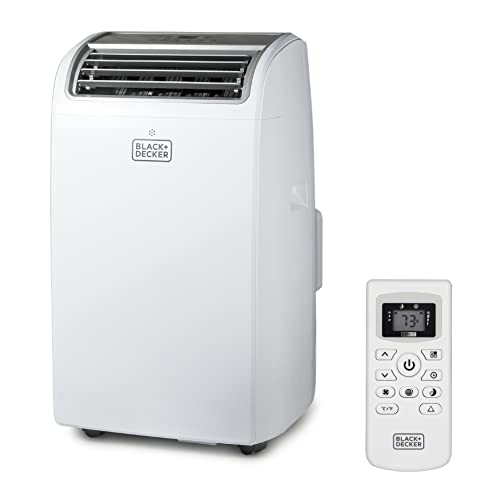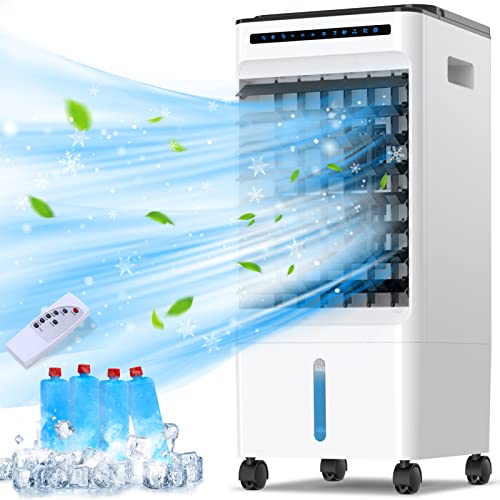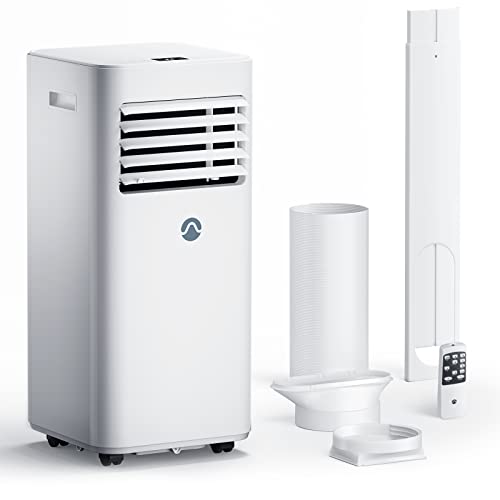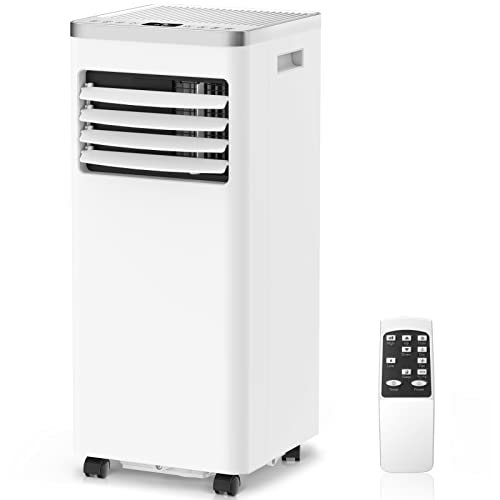Portable Air Conditioning
Portable air conditioning units offer a flexible and efficient solution for keeping our living spaces cool and comfortable. A few top picks include the Whynter Dual Hose with 14,000 BTU for up to 500 sq. ft., and the Honeywell 12,000 BTU, ideal for medium-sized rooms. Important considerations when choosing a unit include cooling capacity, energy efficiency, noise levels, and ease of installation. We also need to think about the unit's portability features like wheels or casters. These factors collectively guarantee we select a model that meets our cooling needs effectively and efficiently. Let's explore more key details to make an informed choice.
Five of the best Portable Air Conditioner
Let's look at three of the best portable air conditioners available today: the Whynter Dual Hose, the 14,000 BTU Dual Hose, and the Honeywell 12,000 BTU.
Each of these models offers unique features that cater to different cooling needs and room sizes. By comparing their specifications and benefits, we can determine which one might be the best fit for our specific requirements.
These units also feature advanced mechanics and intelligent design, ensuring both energy efficiency and peak performance.
►US Links◄
➜ 5. SereneLife 8,000 BTU Portable Air Conditioner - https://amzn.to/3MsKOJg
➜ 4. Black+Decker 8,000 BTU Portable Air Conditioner - https://amzn.to/3Z8i7Je
➜ 3. DeLonghi 14,000 BTU Portable Air Conditioner - https://amzn.to/3AHdMT9
➜ 2. Midea Duo 14,000 BTU Portable Air Conditioner - https://amzn.to/3Z92fpN
➜ 1. Whynter ARC-14S Portable Air Conditioner - https://amzn.to/3Tcfpid
Whynter Dual Hose

When considering portable air conditioning options, the Whynter Dual Hose stands out for its powerful cooling capacity and versatile features, making it an excellent choice for those needing to cool larger spaces up to 500 sq. ft.
The Whynter ARC-143MX offers 14,000 BTU and operates quietly at less than 51.5 dBA. It's capable of dehumidifying up to 91 pints per day, ideal for humid environments.
With three modes—cool, dehumidify, and fan—it provides full thermostatic control from 61°F to 89°F. The advanced dual hose operation guarantees efficient airflow and self-evaporation.
Installation is straightforward with the included window kit and remote. Maintenance is minimal but requires periodic water reservoir emptying.
Overall, it's a robust and reliable unit for larger areas.
Best For: Those seeking a powerful and versatile portable air conditioning unit capable of cooling larger spaces up to 500 sq. ft.
Pros:
• High cooling capacity of 14,000 BTU
• Quiet operation at less than 51.5 dBA
• Advanced dual hose operation for efficient airflow and self-evaporation
Cons:
• Can struggle in extremely high temperatures
• Noise level may be an issue for sensitive users
• Requires periodic emptying of the water reservoir, especially in high humidity
Price in Amazon: https://amzn.to/3APsfwq
14,000 BTU Dual Hose

For those of us seeking efficient and versatile cooling solutions, the Whynter Inverter Portable Air Conditioner stands out as a top contender with its 14,000 BTU capacity.
This award-winning unit, recognized by Forbes and U.S. News & World Report in 2023, is suitable for rooms up to 600 sq. ft. It offers four operational modes: auto, cool, dehumidify, and fan with two speeds.
The built-in dehumidifier can handle up to 87 pints per day and features an auto drain function. Smart Wi-Fi control via the NetHome Plus app allows compatibility with Alexa and Google Home.
Its energy-efficient inverter technology provides 20% more cooling and uses 40% less energy. Installation is straightforward with the included window kit, and the dual hose design guarantees no heat leakage.
Best For: Individuals seeking an efficient, smart-controlled portable air conditioner capable of cooling rooms up to 600 sq. ft. with versatile modes and high energy efficiency.
Pros:
• Award-winning performance with recognition from Forbes and U.S. News & World Report in 2023.
• Energy-efficient inverter technology provides 20% more cooling with 40% less energy consumption.
• Smart Wi-Fi control compatible with Alexa and Google Home.
Cons:
• Some users reported issues with Alexa functionality.
• Dual hose design limits placement options to window installations.
• Potential water leakage during rain due to window installation setup.
Price in Amazon:https://amzn.to/4dShmsn
Honeywell 12,000 BTU

The Honeywell 12,000 BTU Portable Air Conditioner stands out for anyone needing powerful cooling in medium-sized spaces up to 550 sq. ft.
With its compact dimensions of 13.6 x 16.3 x 28 inches and a weight of 59.5 lbs, this unit is easy to move thanks to its smooth-gliding wheels. It offers a dehumidification capacity of 95 pints per day, making it ideal for humid environments.
Included components such as a remote control, window kit, and batteries guarantee straightforward installation and operation.
While some users find the cooling performance effective, especially in open concept areas, others report mixed results in extreme heat.
Overall, it's a practical choice for bedrooms, living rooms, and kitchens, though it may not be most favorable for larger or hotter spaces.
Best For: Anyone needing powerful cooling in medium-sized spaces up to 550 sq. ft., such as bedrooms, living rooms, and kitchens.
Pros:
• Easy installation with included exhaust hose and window bracket
• Built-in dehumidifier removes up to 95 pints of moisture daily
• Compact and portable with smooth-gliding wheels
Cons:
• Mixed reviews on cooling efficiency in high temperatures
• Remote control design criticized for lack of clear instructions
• Some users experienced delivery delays and issues with app connectivity
Price in Amazon:https://amzn.to/3MxR82p
Factors to Consider When Purchasing Portable Air Conditioning
When we're looking at portable air conditioners, we need to take into account several key factors to make a smart choice.
Cooling capacity, energy efficiency, and noise levels will affect how well the unit performs in our space. Additionally, portability features and installation requirements can impact the ease of use and setup.
It's also important to evaluate the BTU rating, as it indicates the heat removal capacity, and choose a unit with the appropriate BTU for your room size.
Furthermore, assessing whether the unit has additional functions like heating or dehumidification can enhance its year-round utility.
Cooling Capacity
Understanding the cooling capacity of a portable air conditioner is vital when deciding which model to purchase. The cooling capacity, measured in BTUs (British Thermal Units), determines how well the unit can cool a specific area.
We need to evaluate the size of the room, the cooling technology used, and how efficiently the unit circulates air. Larger rooms require higher BTU ratings for effective temperature control.
Portable units also vary in their ability to manage air circulation. A model with a strong fan will distribute cool air more evenly, preventing hot spots.
When evaluating a unit, we should look at its space requirements. Some units need more room for proper ventilation and might have specific placement needs, like proximity to windows or electrical outlets.
Maintenance tips are important for ensuring long-term performance. Regular cleaning of filters and coils, checking the drain for clogs, and ensuring the proper sealing of exhaust hoses can help maintain efficiency.
Energy Efficiency
Many of us overlook energy efficiency when choosing a portable air conditioner, but it's essential for both our wallets and the environment. When evaluating energy-saving features, we should consider units with a high Energy Efficiency Ratio (EER). A higher EER means the unit uses less electricity to provide the same cooling, making it more cost-effective in the long run.
Eco-friendly options are also worth exploring. Some models use refrigerants that have a lower climate impact, reducing our carbon footprint. Additionally, units with programmable timers or smart technology can optimize cooling schedules, ensuring the air conditioner runs only when necessary. This not only saves energy but also extends the lifespan of the device.
We should also look for Energy Star-rated models. These units meet strict energy-saving guidelines set by the government, ensuring they're among the most efficient on the market.
Noise Levels
While energy efficiency is a critical factor in choosing a portable air conditioner, we shouldn't overlook noise levels, which can greatly impact our comfort.
A unit's noise output can be just as important as its cooling capacity, especially if we plan to use it in a bedroom or office.
When evaluating portable air conditioners, we need to take into account sound levels. Most units list their noise levels in decibels (dB), and it's helpful to know that a lower number means quieter operation.
For context, normal conversation typically measures around 60 dB.
Noise reduction features are also worth noting. Many modern units include advanced acoustic design to minimize sound, such as insulated compressor compartments and specialized fan settings that operate more quietly.
Additionally, some units offer multiple fan settings, allowing us to adjust the speed and, consequently, the noise level.
Lower fan settings usually mean quieter operation, which can be particularly useful during nighttime.
Portability Features
How can we guarantee our portable air conditioner is truly portable? First, we need to look for a compact design. A smaller unit can fit into tighter spaces, making it easier to move around our home.
Easy mobility is another vital factor. Wheels or casters on the bottom of the unit allow us to roll it from room to room without much effort.
Lightweight construction is also fundamental. A lighter air conditioner guarantees we can lift and carry it without straining ourselves. We should check the specifications for the weight and compare it to other models.
Another feature to take into account is flexible placement. Some units come with adjustable vents and hoses, which allow us to position them in various locations without compromising on efficiency.
Lastly, user friendly controls make a big difference. Simple, intuitive buttons and a clear display mean we can easily adjust settings without getting frustrated. Remote controls can add even more convenience.
Installation Requirements
After confirming our portable air conditioner meets all the portability features, we need to evaluate the installation requirements to make an informed purchase.
First, let's examine ventilation options. Most portable air conditioners require a window or an external vent to expel hot air. We'll need to check if our room has suitable windows or if we need additional venting kits.
Next, let's discuss power requirements. It's essential to verify our chosen unit matches the electrical capacity of our room. Most portable air conditioners run on standard 115-volt outlets, but higher capacity units may need a dedicated circuit. We should confirm our power setup to avoid any electrical issues.
Drainage solutions are another significant factor. Some units come with self-evaporative systems, while others may require manual draining or a continuous drainage hose. We'll need to decide which option fits our needs and convenience.
Installation tools are also something to assess. While most units come with necessary installation kits, we might need additional tools like screwdrivers or tape measures. Checking the installation instructions beforehand guarantees we're prepared.
Lastly, room size matters. We should match the unit's cooling capacity (measured in BTUs) to our room size for efficient cooling.
Evaluating these factors helps us make a sound purchase decision.
Frequently Asked Questions
How Do Portable Air Conditioners Differ From Window Units?
Window units and portable air conditioners differ in design features, installation process, cooling capacity, maintenance requirements, and cost comparison. We find window units often have higher cooling capacity, while portable units offer easier installation and mobility.
Are Portable Air Conditioners Energy-Efficient?
When considering energy consumption and cooling capacity, we find portable units can be less efficient than window units. Installation requirements and maintenance tips impact cost effectiveness, but overall, they're often more convenient despite potential higher energy use.
Can I Use a Portable Air Conditioner in Multiple Rooms?
It's no coincidence that mobility advantages make it easy to use in multiple rooms. Installation tips are essential. Guarantee cooling capacity fits room size compatibility. Don't forget maintenance requirements for ideal performance. Let's enjoy versatile cooling!
How Often Do I Need to Clean the Filter?
We should clean the filter every two weeks for ideal air quality and cooling efficiency. Regular filter maintenance, especially with seasonal cleaning, guarantees our unit runs smoothly. For usage tips, always check the manufacturer's guidelines.
What Are the Noise Levels of Portable Air Conditioners?
Let's discuss noise levels. Decibel ratings typically range from 50-70 dB. Models with sound insulation offer quieter operation. User experiences vary, but many find them manageable. Always check reviews to gauge how quiet a model operates.
In summary, when choosing a portable air conditioner, it's essential to take into account energy efficiency, noise levels, and portability features. The Whynter Dual Hose, 14,000 BTU Dual Hose, and Honeywell 12,000 BTU models each offer unique benefits. Remember, the best unit for you will depend on your specific needs and installation constraints. Don't let the heat catch you off guard; plan ahead and pick the right portable air conditioner to keep your space cool and comfortable.




